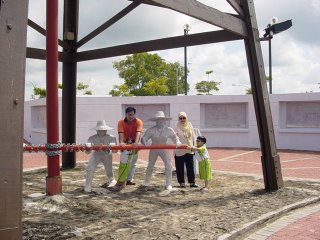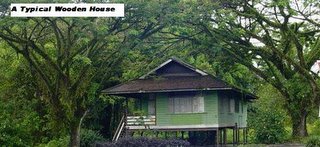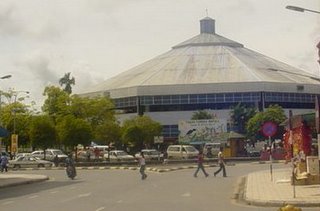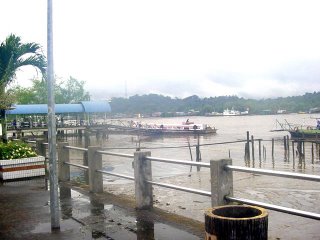We left Bintulu at about 10am and were in Miri at noon. The Boulevard is twenty stories high, one of two tall buildings in Miri. (The one on the right in the picture)

Some other buildings are less than ten stories high while most others are of the three or four storied shop houses and office buildings. The first four stories of The Boulevard is dedicated to shopping with a major shopping mall as its anchor tenant and many other small shopping outlets including a few restaurants, a food-court and fast food outlets. We had late lunch at the food court and browsed around the shopping complex after that. Bought tit bits for the kids and their parents and also their grandparents!! Dedek only wanted “Mentos” candy. Mini bought two bars, each bar contains about a dozen candies and Dedek finished more than half of it at one sitting!! I think he was trying to give a message to mummy that he really likes Mentos so that mummy will buy Mentos more often!! …….Hmmmm, kids have strange ways of communicating to (not with) adults huh?!!
Dinner was at a popular seafood restaurant in town. It was very crowded and the crowd was non Chinese. I spotted only one group of Chinese men having dinner and assume that these men were out of town men unable, for some reason or other, to be home with their loved ones for the Chinese New Year. (It is the tradition that the Chinese have ‘big’ reunion dinners with their families on the eve of Chinese New Year). As it was crowded, ‘and maybe the place is Miri’ (no disrespect intended), dinner took quite sometime to come. We had quite a task to keep baby Haadieya entertained meanwhile, and luckily, when she got tired, she just fell asleep on her daddy’s lap!! How convenient!! When the bill came we were quite surprised to find it somehow ‘inflated??’ Taking advantage of the holiday season perhaps? As the children were tired and sleepy we went back to the apartment immediately afterwards and watched TV, something which I rarely do, and fell asleep somewhere between the start of the movie “The Edge playing Anthony Hopkins and the late news that came on at midnight.
I was not awaken by the late news on TV. I was awakened precisely at midnight by the thunderous banging of fire crackers and fireworks that were continuously booming and lighting the sky of Miri with a myriad of colours and hue. It was all over the town and it lasted for a good two hours. We had a good view from our window in the apartment. I thought there is a ban on firing of firecrackers but………? and I cannot imagine how many hungry mouths can be fed by the money they spent to burn the stuff? Other than the fireworks I also noticed some flares being let off into the sky. The next morning, when I went on my morning walk through the mostly deserted streets of Miri, I saw the fronts of many shops and buildings strewn with the burnt out and shreds of red coloured firecracker wrappings!!
The first day of the Chinese New Year was rather quiet in Miri. Not many cars on the road. We had breakfast at one of the restaurants close to the apartment after which we took a drive to see the city (Miri was given city status only recently). One interesting historical display we visited was the oil museum located on top of a hill, the highest point in all of Miri.

The first ‘on-land’ oil drilling rig which is now dubbed ‘The Grand Old Lady’ (see picture - left) is re-erected outside the museum. This was the first ever rig erected sometime in 1910, used to spud oil on land in the Baram district close to Miri. It was all manually done then and oil was found at a depth of about 450ft. On record, oil was found in the Baram district as early as the 1880’s where local inhabitants used to manually dig out the oil seepage and used it as fuel for cooking and other uses. The discovery led to formal studies being conducted in the area and manual digging carried out. (See picture below: Note the 'manual drillers' in colourful dressing!!) The first commercial production only started in 1910 with 83barrels of oil collected per day. More rigs were built and the volume of oil collected daily increased over time. Of course, the production of oil was controlled by the then foreign oil company (The Anglo-Saxon Oil Company) that was given the lease for oil extraction and the locals? ……. I wonder if they get any benefit from the oil. However, all land side oil fields were closed in 1972 and offshore and sea drilling and production of oil continued since then.
 The grand old lady was preserved and placed on top of the hill known as ‘Canada Hill’. Why Canada Hill, I do not know and I wonder. There must be a story behind this name. The Malaysian Government meanwhile enacted the Petroleum Development Act in 1974, which saw the control of the indigenous oil and gas transferred to the Federal Government and a system of profit sharing, later production sharing and later still cost sharing, with the private oil companies, being implemented, which was more equitable to the country. Look at Miri, Sarawak, Sabah, how little were they developed before the Petroleum Act was enacted, in spite of oil being found in abundance since the late 19th century!!. All proceeds were taken out of the country then!! At least now, with the benefit from the oil and gas accruing to the State and Federal Government, much of the funds were used for development of the state and country, thus benefiting the people. And not just the oil companies!!
The grand old lady was preserved and placed on top of the hill known as ‘Canada Hill’. Why Canada Hill, I do not know and I wonder. There must be a story behind this name. The Malaysian Government meanwhile enacted the Petroleum Development Act in 1974, which saw the control of the indigenous oil and gas transferred to the Federal Government and a system of profit sharing, later production sharing and later still cost sharing, with the private oil companies, being implemented, which was more equitable to the country. Look at Miri, Sarawak, Sabah, how little were they developed before the Petroleum Act was enacted, in spite of oil being found in abundance since the late 19th century!!. All proceeds were taken out of the country then!! At least now, with the benefit from the oil and gas accruing to the State and Federal Government, much of the funds were used for development of the state and country, thus benefiting the people. And not just the oil companies!!We left Miri in the afternoon and had a very easy drive back to Bintulu, taking slightly less than two hours for the trip using the new road. We left Bintulu to return to Petaling Jaya on Monday 30th. There were only 20 passengers on board the flight back to KL from Bintulu. Most people were still in their respective family homes enjoying the holiday. The exodus back to their respective homes starts today and already there are 19 road deaths by this evening? Road deaths due to accidents have, like clockwork, increased this holiday season compared to the same season last year……. I wonder what more need to be done to make drivers and all road users realise that lives are precious and road safety should be on top of their head all the time!! But then, Malaysian drivers forget road safety once they are behind the steering wheel or on their motor bikes…….. what a waste……..
MKI Ramblings Unlimited
Petaling Jaya









